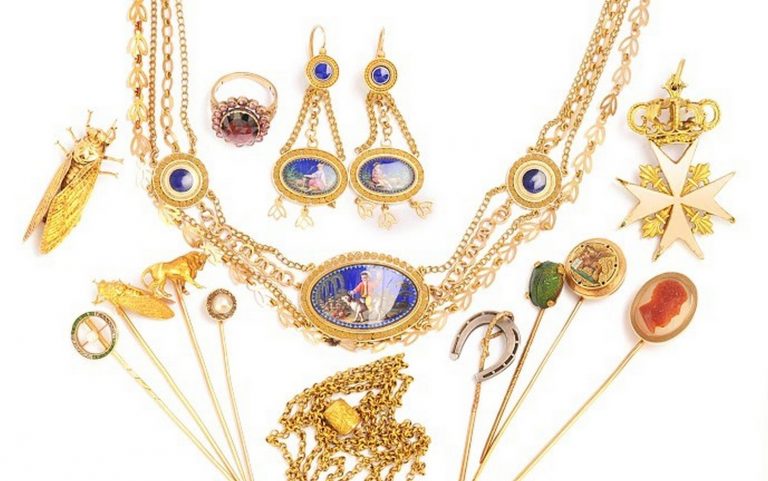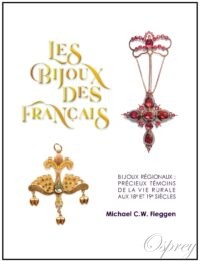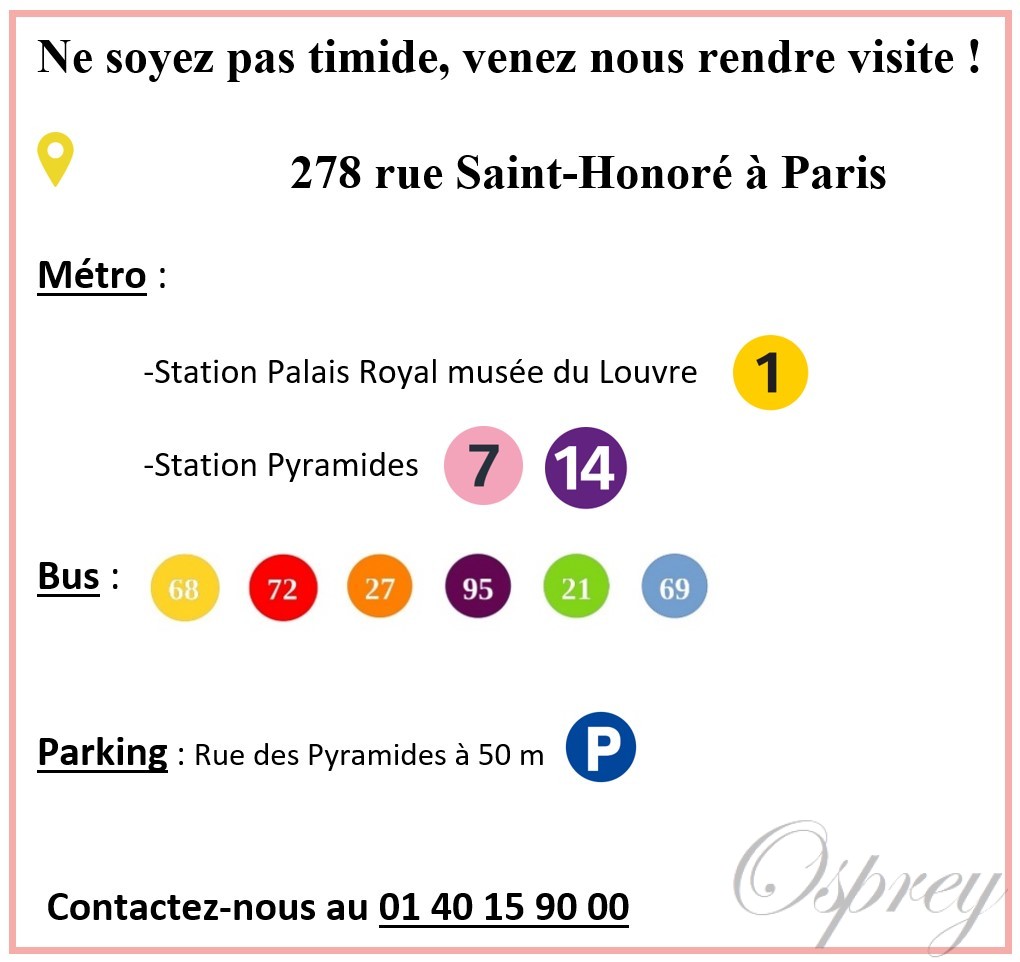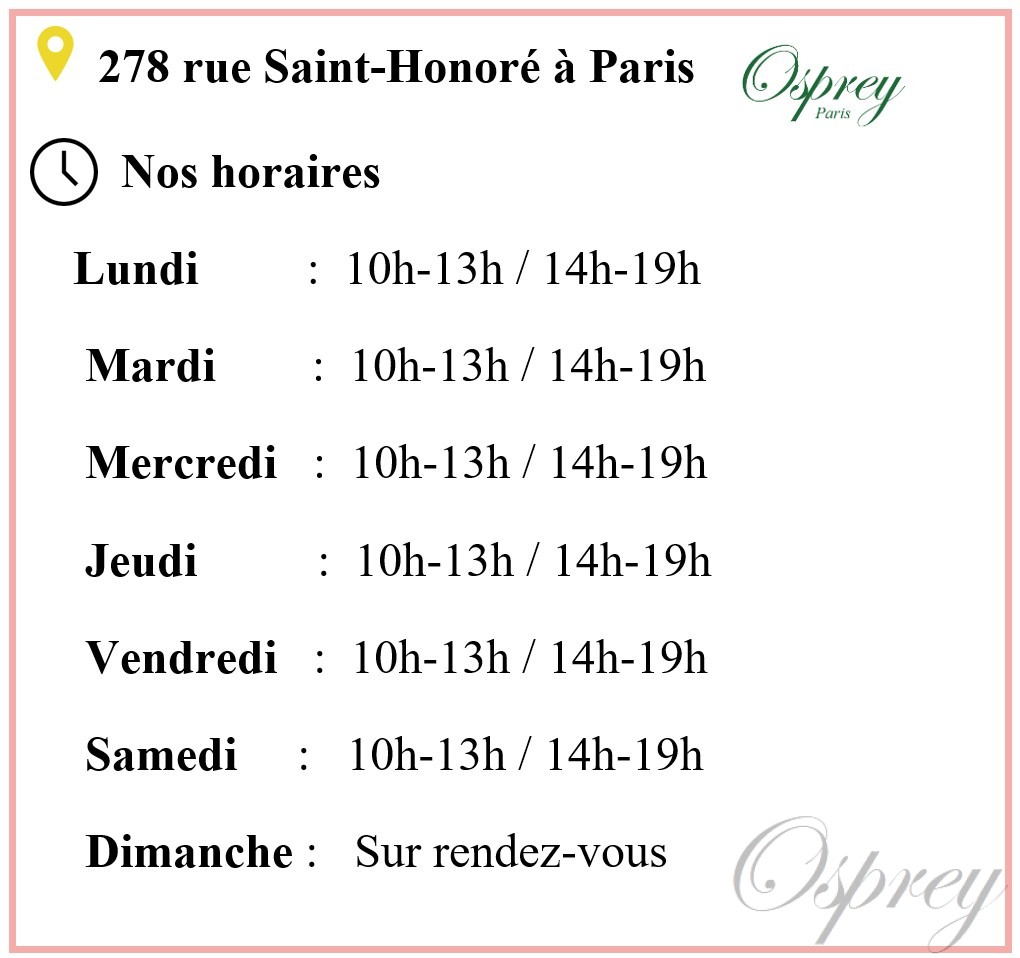Note: This glossary is from the book Traditional French Jewellery by Mike Fieggen, from Osprey Paris and was copyrighted in 2021. No copying without express permission.
A
Alloy (alliage): Mixture of several metals to improve the qualities, attributes or cost price of a piece of jewellery. 18k gold is an alloy of 75% gold with the addition of silver and copper in varying proportions for yellow or pink gold and with palladium, platinum, iron or nickel for white gold.
Amati: Matte finish on gold, silver or platinum, made by removing the polish from them.
Assay office (bureau de garantie): Official authority that tests and then hallmarks jewellery with a mark guaranteeing its fineness. In the past, precious metals were very expensive, and fraud was tempting, while in the days before VAT and income tax, duties collected by the state for hallmarking were a useful source of government revenue. The assay office thus performed a double role of ensuring the quality of precious metals object and taxing their production..
Assay office mark (différent): Tiny figure or symbol engraved within a French hallmark, used to identify the assay office.
B
Bail or bale (bélière): Suspension loop used to suspend a pendant, a cross or a medal. One can then pass a chain or ribbon through the bail to suspend the jewel around the neck.
Bangle (bracelet jonc): A bracelet of which the diameter is uniform. It is called an “opening bangle” when it is oval in shape and opens on a hinge for example.
Blowtorch (chalumeau): In the past, the act of passing a fine jet of air through the flame of an oil lamp would produce an intense flame capable of melting and welding metals. Today, the flame is supplied by the combustion of a gas and oxygen.
Bocfil: Otherwise called a “saw holder”, a frame fitted with a handle that allows very fine saw blades to be inserted in order to cut, re-drill and inscribe metal very precisely. A miniature hacksaw.
Bouterole: Round-headed tool used by goldsmiths to make ring heads, and also by stone engravers to work with emery powder on cameos and intaglios.
C
Cabochon: A stone that has been polished but not faceted on its top surface, convex in shape.
Cameo (camée): Stone composed of different layers of colours and sculpted in relief to expose the various colours. The oldest cameos date from Ancient Greece and Rome. There are also cameos made from seashells, which are more fragile and cheaper.
Cannetille: Decoration of a jewel made by the application of small elements of coiled gold or silver threads.
Carat: A measure of weight used for precious stones, equal to 0.20 grams. Also, a measure of the purity of gold, 24 carat being pure gold, 18 carat equivalent to 75% purity, 9 carat being 37.5% gold.
Champlevé: Enamel technique which consists of engraving or hollowing out the surface of the metal and then filling the hollows with enamel.
Claw (griffe): Small hooks that hold the gemstone in place on a jewel.
Cloisonné: A technique that involves soldering metal wires to the surface of an object and then filling the spaces between the wires with enamel.
Countermark (contremarque): A form of hallmark impressed behind the principal hallmark and obtained by the use of an engraved anvil upon which the object being hallmarked is struck.
Culet (colette, culasse): The flat face on the bottom of a cut gemstone. No longer cut today, it signifies a stone which was cut and polished at least 90 years ago.
Cutting (taille): The processes involved in bringing a rough gemstone to that of a gem ready to be set. These operations are sawing – or cleavage, bruting which gives the general shape of the future cut stone, faceting and final polishing. The purpose of diamond cutting is to give the diamond as much sparkle as possible. The so-called “brilliant” or round cut is the most popular.
D
Dispersion: A prism effect whereby a colourless material breaks down white light into a spectrum of colours. In diamonds, which have an intense dispersive power, dispersion is manifested by spectacular colours.
E
Electrotyping (galvanoplastie): Electrolytic technique for reproducing objects using a mould connected to the negative pole of a battery and upon which a layer of metal is electrolytically deposited.
Enamel (émail): Term that describes both the object and the material with which it is garnished. A powdered vitreous material is applied to an object and then fused in an oven.
Engraving (gravure): Technique of decorating metal objects. Unlike chasing, metal is removed by using chisels.
F
Ferronnière: A sort of necklace that women wore on the forehead during the Renaissance and also between 1820-1840.
Filigree (filigrane): Art technique dating from Antiquity. It consists in working gold or silver threads in a very fine and precise way to make designs which are then soldered together to strengthen them.
Findings (apprêts): Small elements which enter into the composition of a jewel such as chain clasps, earring clips, ring mounts and brooch pins. Findings are generally produced by specialised manufacturers who supply them to jewellers at prices and quality they cannot achieve themselves.
Fineness (titre): In a piece of jewellery, the quantity of precious metal present in relation to the quantity of alloy. In France, gold jewellery is generally 750/1000 (i.e. 18 carats), while silver objects are alloyed at either 800/1000, or 925/1000 (or 950/1000 for older silver). See definition of “carat”.
Fluted: Decorative effect given by flutes, grooves or ridges on an object.
Foil (paillon): Thin sheet of metal placed under a set stone. Usually in silver, it gives the stone more lustre or, if the paillon is coloured, a shimmering colour that varies with the angle of view. Paillons made of gold leaf are also placed under the transparent enamel of the Bresse enamels to give shimmering reflections.
G
Girandole: A type of drop earring formed by clusters of stones. It often represents the shape of fireworks or water jets, rockets or candlesticks with several branches.
Glyptic (glyptique): The art of glyptic comes to us from Ancient Egypt. It consists of engraving stones, as for example in signet rings or sculpting them in relief, as for example cameos.
Godron: Embossed or hollow ornament in the form of a pod or elongated oval, arranged vertically or horizontally. It is found in the decoration of pieces of goldsmith’s work, in jewellery and on decorative vases.
Grainetti (grèneti): Decoration of a surface by the application of miniscule gold spheres.
Guarantee mark (poinçon de garantie): Hallmark inscribed by the assay office to prove that the requisite duties have been collected.
Guillochage: Decorative technique by which a very precise, complex and repetitive pattern is mechanically etched into an underlying material by the use of a machine. Often observed on banknotes.
H
Hallmark (poinçon de titre): A mark guaranteeing the fineness of the metal of the object. Since 1838, a single hallmark acts both as a guarantee hallmark and a title hallmark; it is even sometimes affixed by goldsmiths themselves.
Hardness (dureté): The ability of a gem to resist scratches and wear. The Mohs Scale ranks from the least hard to the hardest, with the 10 of the diamond being the hardest.
Head (Chaton): Upper part of the ring where the stone (s) are embedded. Depending on the model, the head is more or less tall. To emphasise the brilliance of a diamond, the bezels or prongs on yellow gold rings are often made in white gold or platinum.
I
Intaglio (intaille): Term used for a flat stone engraved with an incuse design. In Antique times a common process in various places of the world such as Mesopotamia, Egypt, Greece, and Italy, on seals or amulets for example. This practice was resumed in the Renaissance and again at the beginning of the 19th century.
K
Key shaped (cleché): Shaped like a key. The suspension ring of the Narbonne cross is said to be cleché.
L
Laminated (laminé): Made up of one or two layers of gold laminated to a core of silver or base metal.
Locket: English name used in France in the 19th century for pendants fitted with a photo and sometimes a lock of hair, very popular since the democratisation of photography.
Lustre (éclat): Property related to the scintillating reflection of light on the surface of a gem. We speak of adamantine lustre if it is very high (like that of diamond), of vitreous lustre if it is not very bright (like that of glass or quartz), or resinous lustre (for amber), pearly, silky, mat, etc.
M
Maker’s mark (marque d’orfèvre): Mark used to identify the goldsmith. In a rhombus or oval shape for precious metal objects; necessarily square for plated jewellery. The maker’s mark is stamped by the jeweller before the assay mark.
Marquise: Pointed oval (oblong) bezel ring, mounted on a thin openwork basket. We find this form as early as the 18th century. A shuttle cut diamond is also called a “marquise cut”.
Millegrain: Technique of sculpting the metal setting around stones, in order to highlight them by giving luminosity. The body of the ring is micro-engraved by fine grooves, to highlight reliefs, thereby accentuating the sparkle of the gems.
P
Pavé: Method of setting stones where they are set side by side.
Plique-à-jour: Technique of enamelling similar to that of cloisonné, but without a metallic background in its final state, to allow light to filter through transparent or translucent enamel.
Precious stones (pierres précieuses): There are only four precious stones: diamond, ruby, sapphire, and emerald.
Prong (griffe): Small claws or hooks that hold the gemstone in place.
R
Recall hallmark (poinçon de recense): Whenever fake or stolen hallmarks were discovered by the authorities, new hallmarks of different designs were prepared, and all jewellers ordered to present their stock to the assay office for examination. The jewellery was then struck with a special hallmark indicating it had been verified. After the period during which this service was free, any jewels found in a jeweller’s stock would be hallmarked with the new hallmarks and the full fees demanded by the assay office.
Remarking hallmark (poinçon de remarque): Hallmark, with a rhino’s head for example, struck every ten centimetres on a chain to prove that the duties have indeed been correctly paid and that the chain has not been lengthened subsequent to its inspection and hallmarking by the assay office.
Rhinestones (strass): Crystal made from a mixture of glass and lead oxide, with a brilliant shine. The sparkle is sometimes accentuated by setting the stones on silver leaf or by applying mirror-like tinning on the back facets. Invented by the Strasbourg jeweller Georges Frederick Strass in 1746, rhinestones quickly conquered the jewellery market with their brilliance and low price.
Rolled gold (doublé): Made up of one or two layers of gold laminated to a core of silver or base metal.
Rolling mill (laminoir): A machine for rolling gold or silver by passing the metal between two cylinders. The action of rolling consists of reducing a metal into a long sheet, giving it a uniform thickness by a regular compression.
Rose-cut (taille rose): Old diamond cut with faceted top surface and a flat base. There is virtually no refraction and return of light from the inside: the shine comes only from the fact that the facets are very reflective due to the extreme hardness of the diamond.
S
Setting (sertir): Inserting, setting a stone in the setting of a piece of jewellery, for example in the bezel or head of a ring.
Slide (coulant): Small jewel often in the shape of a hollow heart, with three holes or two straps behind, through which was passed a chain or the suspension ribbon of a cross. It allowed the height of the suspension of the cross to be adjusted without having to retie the ribbon, and also to lower the cross into a point in the bust of the wearer.
Stamped (estampé): Jewel formed by the action of a press or balance on a sheet of metal between two dies.
T
Testing needles (touchau): Tool used to compare the test results for fineness of gold or silver. The tip of each branch of this metal star or set of small rods is made of a different grade of gold and is used to compare the reactions of precious metals with acids and thus determine their purity when tested on a touchstone.
Touchstone (pierre de touche): Flat black abrasive stone used to test the purity of precious metals by making a mark on the stone and then applying a drop of acid to observe the reaction or lack of it.
Trissou: Small pestle-shaped pendant suspended from Huguenot crosses.
V
Vermeil: Silver covered with a gold coating. Now carried out by electrolysis, this process was once done by applying a mixture of gold and mercury. Vermeil has a particular soft yellow tone and is hallmarked as silver.
Y
You and Me (Toi-et-Moi): Term which designates a ring mounted with two stones.
Osprey Paris
278 rue Saint-Honoré
75001 Paris 01 4015 9000

Our team of experts:

Melinda, expert gemologist,
expert jeweler since 1987

Mike, jeweler since 1981,
antique jewelry expert
and hallmarks, author
of the reference book
The Jewels of the French .







